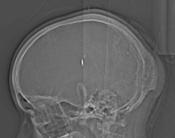Spiculated periosteal reaction
Updates to Article Attributes
Body
was changed:
Spiculated periosteal reaction represents spicules of new bone forming-forming along vascular channels and the fibrous bands that anchor tendons to bone (Sharpey fibres).
Pathology
A spiculated periosteal reaction signifies a rapid underlying process that prevents the formation of new bone under the raised periosteum.
Aetiology
The orientation of the spicules reflects the direction of tumour growth. Spiculated periosteal reactions can be divided into subtypes based on the orientation of the spicules:
Perpendicular (hair-on-end)
Divergent (sunburst)
- osteosarcoma
- haemangioma
- osteoblastic metastasis
- prostatic
- bronchoalveolar
- carcinoid
- breast
- neuroblastoma (paediatric age group)
- osteoblastoma
Focal slopping (velvet)
See also
-<p><strong>Spiculated periosteal reaction</strong> represents spicules of new bone forming along vascular channels and the fibrous bands that anchor tendons to bone (<a href="/articles/sharpey-fibres">Sharpey fibres</a>). A spiculated periosteal reaction signifies a rapid underlying process that prevents formation of new bone under the raised periosteum.</p><p>The orientation of the spicules reflects the direction of tumour growth. Spiculated periosteal reactions can be divided into subtypes based on the orientation of the spicules:</p><h5>Perpendicular (hair-on-end)</h5><ul>- +<p><strong>Spiculated periosteal reaction</strong> represents spicules of new bone-forming along vascular channels and the fibrous bands that anchor tendons to bone (<a href="/articles/sharpey-fibres">Sharpey fibres</a>).</p><h4>Pathology</h4><p>A spiculated periosteal reaction signifies a rapid underlying process that prevents the formation of new bone under the raised periosteum.</p><h4>Aetiology</h4><p>The orientation of the spicules reflects the direction of tumour growth. Spiculated periosteal reactions can be divided into subtypes based on the orientation of the spicules:</p><h5>Perpendicular (hair-on-end)</h5><ul>
-<li>metastasis</li>- +<li><a title="Skeletal metastasis" href="/articles/skeletal-metastasis-1">metastasis</a></li>
-<li><a href="/articles/adenocarcinoma-in-situ-minimally-invasive-adenocarcinoma-and-invasive-adenocarcinoma-of-lung">bronchoalveolar</a></li>- +<li><a href="/articles/adenocarcinoma-in-situ-minimally-invasive-adenocarcinoma-and-invasive-adenocarcinoma-of-lung-1">bronchoalveolar</a></li>
References changed:
- 1. Wenaden A, Szyszko T, Saifuddin A. Imaging of Periosteal Reactions Associated with Focal Lesions of Bone. Clin Radiol. 2005;60(4):439-56. <a href="https://doi.org/10.1016/j.crad.2004.08.017">doi:10.1016/j.crad.2004.08.017</a> - <a href="https://www.ncbi.nlm.nih.gov/pubmed/15767101">Pubmed</a>
- 1. Wenaden AE, Szyszko TA, Saifuddin A. Imaging of periosteal reactions associated with focal lesions of bone. Clin Radiol. 2005;60 (4): 439-56. <a href="http://dx.doi.org/10.1016/j.crad.2004.08.017">doi:10.1016/j.crad.2004.08.017</a> - <a href="http://www.ncbi.nlm.nih.gov/pubmed/15767101">Pubmed citation</a><div class="ref_v2"></div>
Tags changed:
- cases
- case3
Images Changes:
Image 1 Diagram ( update )

Position
was set to
.
Image 6 CT (Scanogram) ( update )

Position
was set to
.







 Unable to process the form. Check for errors and try again.
Unable to process the form. Check for errors and try again.